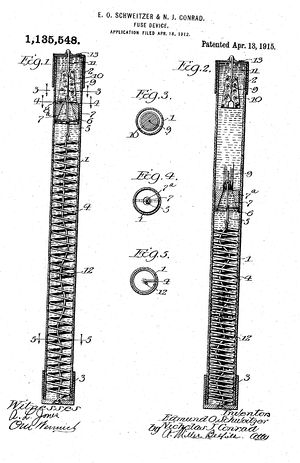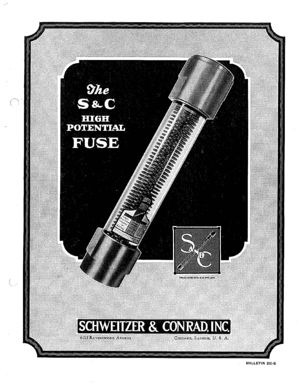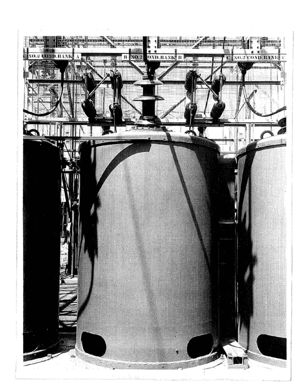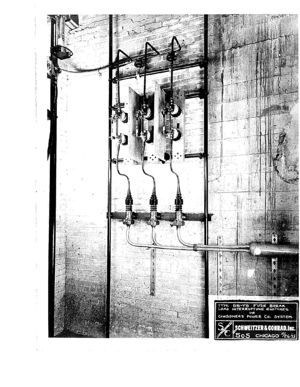|
|
| Line 1: |
Line 1: |
| == First Wireless Radio Broadcast by Reginald A. Fessenden, 1906 ==
| | ''Reliable High-Voltage Power Fuse, 1909'' |
|
| |
|
| ''On 24 December 1906, the first radio broadcast for entertainment and music was transmitted from [[Brant Rock|Brant Rock]], Massachusetts to the general public. This pioneering broadcast was achieved after years of development work by Reginald Aubrey Fessenden (1866-1932) who built a complete system of wireless transmission and reception using amplitude modulation (AM) of continuous electromagnetic waves. This technology was a revolutionary departure from transmission of dots and dashes widespread at the time.'' | | ''In 1909 Nicholas J. Conrad and Edmund O. Schweitzer developed an extremely reliable high voltage power fuse which used an arc-extinguishing liquid to assure proper interruption of short circuits. These fuses, later manufactured at this location, played a major role in the adoption of outdoor distribution substations, and the technology remains a central component of electrical transmission and distribution systems today.''<br> |
|
| |
|
| The plaque may be viewed at the antenna base at Blackman's Point, 2 Central Street, Brant Rock, Massachusetts. For access to the property, contact Dana Blackman +1 781 834 4755
| | [[Image:S & C Fuse.jpg|thumb|right]] |
|
| |
|
| == January 1906: Rotary-spark transmitter and first two-way transatlantic transmission ==
| | [[Image:Pat1135548.jpg|thumb|right|Schweitzer and Conrad Patent]] |
|
| |
|
| Using his rotary-spark transmitters, Fessenden made the first successful two-way transatlantic transmission, exchanging Morse code messages between the station at Brant Rock and an identical one built at Machrihanish in Scotland. (Note that Marconi had only achieved one-way transmissions at this time.) However, the transmitters could not bridge this distance during daylight hours or in the summer, so work was suspended until later in the year. Unfortunately, the Machrihanish radio tower collapsed, abruptly ending the transatlantic work.
| | [[Image:S&C Fuse South Cal.jpg|thumb|right]] |
|
| |
|
| == December 21, 1906: Alternator-transmitter used for wireless telephony ==
| | [[Image:Consumers Power.jpg|thumb|right]] |
|
| |
|
| Fessenden gives a major demonstration of his new high frequency alternator-transmitter at Brant Rock, showing its utility for point-to-point wireless telephony, by interconnecting his stations (at Plymouth and Brant Rock) to the Bell telephone network. Prominent experts, Elihu Thompson and Greenleaf Pickard, together with others, witnessed the event. Refer to an article entitled “Experiments and Results in Wireless Telephony” published in The American Telephone Journal. On January 26, 1907. See URL Experiments and Results in
| | <br>This invention provided an economical, reliable means for interrupting high-current short-circuits in electric utility substations. It allowed utilities to expand their delivery of dependable electrical service to businesses and consumers. |
|
| |
|
| == 1906: Three days before Christmas Eve (Helen Fessenden’s book, p. 153) ==
| | This fuse design was much more reliable than previous power fuses. At the time, breakdowns in electrical substations were common, negatively impacting service reliability for customers of electric utilities. Often, the problems were found to be attributable to poorly performing fault protection equipment. |
|
| |
|
| Reginald Fessenden plans to give two radio broadcasts, on Christmas Eve and New Year’s Eve. Station staff notifies the ships of the US Navy and of the United Fruit Company to listen. These ships had previously been fitted with radio receivers.
| | The inspiration for the device came to the inventors—two Commonwealth Edison engineers, Nicholas J. Conrad and Edmund O. Schweitzer—after they investigated a fire at the Fisk Street Generating Station. They concluded that the cause of the fire was a power fuse failure. |
|
| |
|
| == December 24, 1906 ==
| | Schweitzer and Conrad’s fuse design differed from predecessors through its use of a special arc-extinguishing liquid that assured proper interruption of short circuits, and a fusible element that offered unmatched precision in operating only when called upon. The fuse was constructed to withstand the very high temperatures associated with interrupting high-current faults, and was sufficiently rugged so it could be applied outdoors. |
|
| |
|
| Alternator-transmitter and the first radio broadcast.<br>Landmark broadcast of transmission of ordinary speech and music from Brant Rock to ships sailing along the Atlantic coast. A repeat broadcast performance was given on New Years Eve. Reception is confirmed by the listeners.
| | The Schweitzer and Conrad Liquid Power Fuse played a major role in the adoption of outdoor distribution substations—a central component of electrical transmission and distribution systems today. |
|
| |
|
| The historical site is located at Blackman’s Point, Brant Rock, in the County of Plymouth Massachusetts. Blackman’s Point is a few miles from the center of Marshfield. The Town of Marshfield is approximately 30 miles south-east of Boston. The remaining concrete foundation built to support Fessenden’s wireless tower, is in a trailer park owned by the Blackman family at the south end of the town of Brant Rock, off of Central St.
| | <br> |
|
| |
|
| == References Provided with the Nomination == | | == Images and Further Reading == |
|
| |
|
| 1. John S. Belrose, “ More on Fessenden,” [[IEEE Spectrum|''IEEE Spectrum'']] August 1992, pp.11, 70.
| | [[Media:Pat1135548.pdf|Schweitzer and Conrad Patent]] |
|
| |
|
| 2. John S. Belrose, [http://fessendenmilestone.quartomese.com/Documents/FessendenWireless.pdf “Reginald Aubrey Fessenden and the Birth of Wireless Telephony,”] ''IEEE Antennas and Propagation Magazine'' Vol .44, No. 2, April 2002.
| | [[Media:Bulletin_200-A_1-28-10.pdf|1910 Bulletin]] |
|
| |
|
| 3. James E. Brittain, “ Scanning the Past: Reginald A. Fessenden and the Origins of Radio,” ''Proceeding of the IEEE'', Vol. 84, No. 12, December 1996, pp. 1852-3.
| | [[Media:Bulletin_200-B_10-30-12.pdf|1912 Bulletin]] |
|
| |
|
| 4. [http://query.nytimes.com/mem/archive-free/pdf?res=F30617FE3C5412738DDDAA0A94DA415B898CF1D3 “Fessenden Wireless ‘Phone,'” New York Times], 23 December 1909.13. Helen Fessenden, ''[http://archive.org/details/fessendenbuilder006701mbp Fessenden: Builder of Tomorrows]'', 1940.
| | [[Media:Instruction_Sheet_210.pdf|Fuse Installation Instructions]] |
|
| |
|
| 5. Reginald A. Fessenden, “Recent Progress in Wireless Telephony,” [http://ia600807.us.archive.org/14/items/scientific-american-1907-01-19/scientific-american-v96-n03-1907-01-19.pdf ''Scientific American'', January 19, 1907], p. 68.
| | '''Additional Images:''' |
|
| |
|
| 6. L.A. Geddes, “Remembering Fessenden,” [[IEEE Spectrum|''IEEE Spectrum'']] June 1992, p. 6.
| | [[Media:South._Cal._Ed._1.pdf|South. Cal. Ed. 1]] |
|
| |
|
| 7. John Grant, [http://books.google.com/books?id=APMgAQAAMAAJ&lpg=PA64-IA1&ots=mGU6OBBWld&dq=American%20Telephone%20Journal%2C%20January%2026%2C%201907&pg=PA49#v=onepage&q&f=false "Experiments and Results in Wireless Telephony,"] ''American Telephone Journal'', January 26, 1907, pp. 49-51.
| | [[Media:South._Cal._Ed._2.pdf|South. Cal. Ed. 2]] |
|
| |
|
| 8. S.M. Kintner, “Pittsburgh’s Contribution to Radio,” ''Proceeding of the Institute of Radio Engineers'', Vol. 20, No. 12, December 1932.
| | [[Media:South._Cal._Ed._3.pdf|South. Cal. Ed. 3]] |
|
| |
|
| 9. S.M. Kintner, [http://query.nytimes.com/mem/archive-free/pdf?res=F70A17FE345D13738DDDA80A94DD405B848DF1D3 “Wireless Telephony,”] ''New York Times'', May 21, 1914.
| | [[Media:South._Cal._Ed._4.pdf|South. Cal. Ed. 4]] |
|
| |
|
| 10. Mark Schmidt, “Radio’s First Voice,” ''The Marshfield Reporter'', June 16, 2006.
| | [[Media:Duquesne_Light_11-30-22.pdf|Duquesne Light]] |
|
| |
|
| 11. [http://www.google.com/patents/US706737 U.S. Patent 706,737], Wireless Telegraphy. August 12, 1902.
| | [[Media:Consumers_Power_11-26-28.pdf|Consumers Power 11-26-28]] |
|
| |
|
| 12. [http://www.google.com/patents/US706747 U.S. Patent 706,747], Apparatus for Signaling by Electromagnetic Waves. August 12, 1902.
| | <br> |
|
| |
|
| 13. [http://fessendenmilestone.quartomese.com/Documents/Globe.pdf “Wireless Station at Brant Rock has been in touch with Egypt,”] ''Boston Globe'', June 26, 1910.
| | == Letter from the site owner giving permission to place IEEE milestone plaque on the property == |
| | |
| | [[Media:SC_Milestone_permission_Letter-2.doc|High Voltage Fuse Milestone Support Letter]] |
| | |
| | <br> |
| | |
| | == Proposal and Nomination == |
| | |
| | [[Milestone-Proposal:Worlds First Reliable High Voltage Power Fuse]]<br><br>[[Milestone-Nomination:Worlds First Reliable High Voltage Power Fuse]] |
|
| |
|
| == Map == | | == Map == |
|
| |
|
| {{#display_map:42.081973, -70.640951~ ~ ~ ~ ~Blackman’s Point, Brant Rock, in the County of Plymouth Massachusetts|height=250|zoom=10|static=yes|center=42.081973, -70.640951}} | | {{#display_map:42.001466, -87.679368~ ~ ~ ~ ~S & C, Chicago, IL, USA|height=250|zoom=10|static=yes|center=42.001466, -87.679368}} |
|
| |
|
| [[Category:News|Radio]] [[Category:Radio_communication|Radio]] [[Category:Radio_broadcasting|Radio]] | | [[Category:Computing_and_electronics|{{PAGENAME}}]] |
| | [[Category:Engineering_fundamentals|{{PAGENAME}}]] |
Reliable High-Voltage Power Fuse, 1909
In 1909 Nicholas J. Conrad and Edmund O. Schweitzer developed an extremely reliable high voltage power fuse which used an arc-extinguishing liquid to assure proper interruption of short circuits. These fuses, later manufactured at this location, played a major role in the adoption of outdoor distribution substations, and the technology remains a central component of electrical transmission and distribution systems today.

Schweitzer and Conrad Patent
This invention provided an economical, reliable means for interrupting high-current short-circuits in electric utility substations. It allowed utilities to expand their delivery of dependable electrical service to businesses and consumers.
This fuse design was much more reliable than previous power fuses. At the time, breakdowns in electrical substations were common, negatively impacting service reliability for customers of electric utilities. Often, the problems were found to be attributable to poorly performing fault protection equipment.
The inspiration for the device came to the inventors—two Commonwealth Edison engineers, Nicholas J. Conrad and Edmund O. Schweitzer—after they investigated a fire at the Fisk Street Generating Station. They concluded that the cause of the fire was a power fuse failure.
Schweitzer and Conrad’s fuse design differed from predecessors through its use of a special arc-extinguishing liquid that assured proper interruption of short circuits, and a fusible element that offered unmatched precision in operating only when called upon. The fuse was constructed to withstand the very high temperatures associated with interrupting high-current faults, and was sufficiently rugged so it could be applied outdoors.
The Schweitzer and Conrad Liquid Power Fuse played a major role in the adoption of outdoor distribution substations—a central component of electrical transmission and distribution systems today.
Images and Further Reading
Schweitzer and Conrad Patent
1910 Bulletin
1912 Bulletin
Fuse Installation Instructions
Additional Images:
South. Cal. Ed. 1
South. Cal. Ed. 2
South. Cal. Ed. 3
South. Cal. Ed. 4
Duquesne Light
Consumers Power 11-26-28
Letter from the site owner giving permission to place IEEE milestone plaque on the property
High Voltage Fuse Milestone Support Letter
Proposal and Nomination
Milestone-Proposal:Worlds First Reliable High Voltage Power Fuse
Milestone-Nomination:Worlds First Reliable High Voltage Power Fuse
Map
Loading map...
{"minzoom":false,"maxzoom":false,"mappingservice":"leaflet","width":"auto","height":"250px","centre":{"text":"","title":"","link":"","lat":42.001466,"lon":-87.679368,"icon":""},"title":"","label":"","icon":"","lines":[],"polygons":[],"circles":[],"rectangles":[],"copycoords":false,"static":true,"zoom":10,"defzoom":14,"layers":["OpenStreetMap"],"image layers":[],"overlays":[],"resizable":false,"fullscreen":false,"scrollwheelzoom":true,"cluster":false,"clustermaxzoom":20,"clusterzoomonclick":true,"clustermaxradius":80,"clusterspiderfy":true,"geojson":"","clicktarget":"","imageLayers":[],"locations":[{"text":"","title":"","link":"","lat":42.001466,"lon":-87.679368,"icon":"","inlineLabel":"S \u0026amp; C, Chicago, IL, USA\n"}],"imageoverlays":null}



